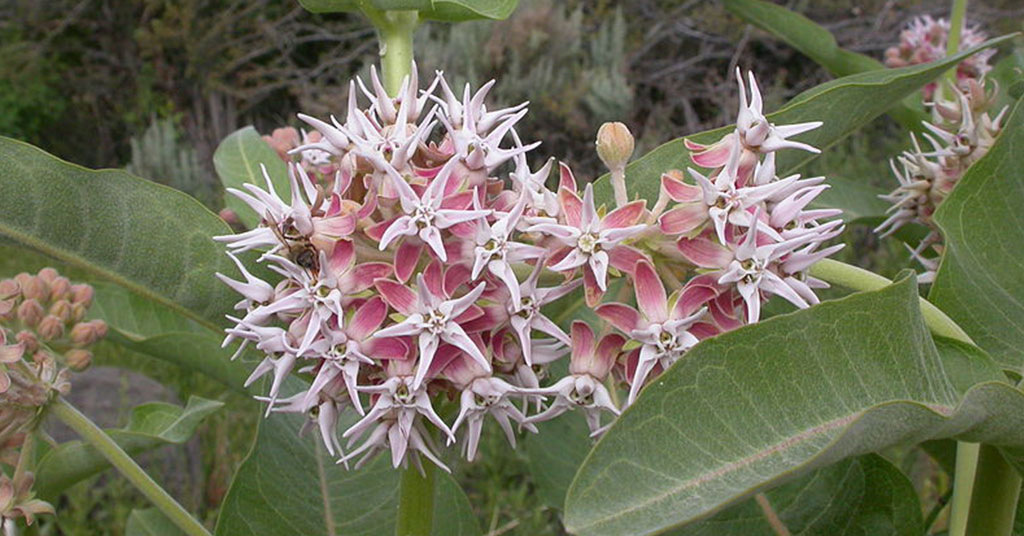If you want a hardy, native perennial wildflower in your garden that will wow guests, thrill your native pollinators, and attract Monarch butterflies, Showy Milkweed is just the flower for you. In this article, we’ll do a deep dive on this awesome wildflower, how to grow it, and what care considerations you should take.
Additional varieties of milkweed include: Swamp milkweed (A. incarnata), Common milkweed (A. syriaca), and Butterfly weed (A. tuberosa). Swamp milkweed and butterfly weed are both extremely decorative plants with several varieties.
What is Showy Milkweed?
Showy Milkweed is one of a handful of species of milkweed flower and plays host to the caterpillars of the Monarch butterfly. It is a tall-growing perennial wildflower native to much of Central and Western North America, extending northward into central Canada and southward into Texas. Milkweed’s tiny, star-shaped blossoms are well built for pollination. The huge seed pods that form from the fertilized blooms are very nicely formed. These skilled self-sowers break open in the fall, releasing hundreds of seeds.
- Scientific name: Asclepias speciosa
- Native to: Western and Central North America
- Invasiveness: No
- Tenderness: Perennial
- Sun: Full
- Water: Moist
- Soil: Well-draining soil
- Hardiness zone: 3-9
- Spacing: 18 inches
- Plant height: 3 feet
- Flower color: Pink, Green, Purple
- Bloom period: May – September
- Container friendly: Yes
- Fertilizer: Not needed
- Toxicity: Yes
- Drought tolerant: No
- Deer resistant: Yes
- Pest resistant: Yes
How to grow Showy Milkweed
Showy Milkweed is just that: showy. Asclepias speciosa wildflower grows up to 3 feet tall when planted in moist, well-draining soil in a sunny spot. A native flower for much of Central and Western North America, this perennial flower is a favorite of butterflies, hummingbirds, and other pollinators. It explodes in showy flowers that are pink, green, and purple for the majority of summer. Its bloom period runs from May to September.
Asclepias speciosa is a hardy perennial plant that doesn’t need special fertilizer considerations. It grows well in containers but is not all that drought tolerant. Deer and pests mostly avoid this plant, unless you consider Monarch caterpillars to be pests. (Please don’t.)
Invasiveness
Showy Milkweed is not listed as a noxious weed by the federal government or any state in the United States. At least five species are recognized as endangered by the state or federal government (Borders, LeeMäder 2014). Some milkweed species, such as common milkweed (Asclepias syriaca), have a reputation for being “weedy” because they are more aggressive in garden settings or disturbed regions. If you are concerned about the proliferation of milkweed in your region, select species that are native to your area and avoid species that are particularly adept at vegetative, clonal reproduction, or are prolific seed producers.
Growing Showy Milkweed in containers
Asclepias speciosa does well when planted in containers, but this is a pretty big wildflower, growing up to 3 feet tall. Take care to plant in a large pot with well-draining soil placed in a sunny location. Water frequently, as Showy Milkweed prefers damp soil.
When to start Asclepias speciosa seeds
Sowing Showy Milkweed seeds outdoors directly into the soil in fall is the best way to go about planting this amazing perennial flower. It won’t sprout right away – the seeds will wait until spring to germinate and begin growing. Watch carefully for Asclepias speciosa seedlings early in the spring after the soil has thawed.
Propagating Showy Milkweed
Starting Asclepias speciosa from seed isn’t the only way to propagate Showy Milkweed. In the fall, you can dig up the roots of your Asclepias speciosa and splitting them up. Replant the sections of root and expect a new milkweed plant to emerge in the spring.
How to collect Asclepias speciosa seeds
In autumn, after Showy Milkweed’s flowers have died back, a large pod will be easily visible. Remove the pod from the top of the Asclepias speciosa plant and split it open at the seam. Inside, you will find dozens of seeds that you can sow directly into the soil in the fall. Avoid milkweed pods that are covered in pests or insects. Please leave some pods on their parent plant in order to let seeds scatter naturally on the wind.
Wildlife attracted by Showy Milkweed
Showy Milkweed, like other varieties of the flower, are known to attract pollinators, like bees, hummingbirds, and butterflies. It’s also the host plant for the Monarch butterfly caterpillar. If you’d like to help save the monarchs, plant Asclepias speciosa!
Common Problems
Milkweed bugs (which don’t cause much harm), aphids, spider mites, whiteflies, thrips, scale insects, and leaf miners are all attracted to common milkweed. Scrape off the offenders using a hose, a bottle, or your fingernails. Snails and slugs enjoy young fragile milkweed plants as well. Snail bait works effectively and does not damage monarch butterflies, although the snail problem fades as the plants mature.
Keep an eye out for fungal issues including verticillium wilt, leaf spots, and root rot. Trim diseased leaves and branches with leaf spots, but the other two fungal problems may be more difficult to solve.













